Declination diagram - Study guides, Class notes & Summaries
Looking for the best study guides, study notes and summaries about Declination diagram? On this page you'll find 23 study documents about Declination diagram.
Page 2 out of 23 results
Sort by
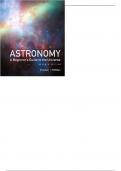
-
Test Bank For Astronomy A Beginners Guide to the Universe 7th edition by Chaisson
- Exam (elaborations) • 413 pages • 2023
-
- $34.45
- + learn more
Chapter 0 Charting the Heavens: The Foundations of Astronomy 1) Right ascension in the sky is very similar to latitude on the Earth. Answer: FALSE Diff: 1 Section Ref.: 0.1 2) Latitude and right ascension are coordinate systems used to find objects on the celestial sphere. Answer: FALSE Diff: 1 Section Ref.: 0.1 3) The celestial sphere is divided into 88 modern constellations. Answer: TRUE Diff: 1 Section Ref.: 0.1 4) In the sky, declination is measured in degrees north or south of th...
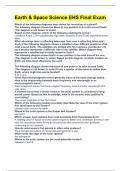
-
Earth & Space Science EHS Final Exam
- Exam (elaborations) • 9 pages • 2024
-
- $11.50
- + learn more
Earth & Space Science EHS Final Exam Which of the following diagrams best shows the revolution of a planet? The following diagram shows the Moon at one position in its orbit around Earth. (The diagram is not drawn to scale.) Based on this diagram, which of the following statements is true? Locations A and C are experiencing high tides; locations B and D are experiencing low tides. What advantage does a reflecting telescope have over a refracting telescope? Each of the following diagrams ...
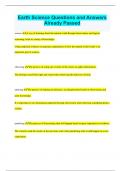
-
Earth Science Questions and Answers Already Passed
- Exam (elaborations) • 14 pages • 2023
- Available in package deal
-
- $9.99
- + learn more
Earth Science Questions and Answers Already Passed science A way of learning about the natural world through observations and logical reasoning; leads to a body of knowledge. Using empirical evidence to generate explanations of how the natural world works is an important part of science. observing The process of using one or more of the senses to gather information. The biologist used both sight and sound when observing the behavior of birds. inferring The process of making an inference; an in...

-
ASTRO 2ND EDITION SHOHINI GHOSE - Test Bank
- Exam (elaborations) • 264 pages • 2023
-
- $24.11
- + learn more
1. Which of the following definitions best describes a constellation? a. a region of the sky containing a certain star pattern b. a group of very bright stars c. a group of very faint stars d. the dividing line between the north and south celestial hemispheres ANSWER: a 2. How many official constellations are there? a. 98 b. 88 c. 13 d. 55 ANSWER: b 3. Which of the following best describes the Big Dipper? a. an asterism b. a faint star near...
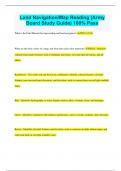
-
Land Navigation/Map Reading (Army Board Study Guide) 100% Pass
- Exam (elaborations) • 14 pages • 2023
- Available in package deal
-
- $9.99
- + learn more
Land Navigation/Map Reading (Army Board Study Guide) 100% Pass What is the Field Manual for map reading and land navigation? FM 3-25.26 What are the basic colors of a map, and what does each color represent? Black - Indicates cultural (man-made) features such as buildings and roads, surveyed spot elevations, and all labels. Red-Brown - The colors red and brown are combined to identify cultural features, all relief features, non-surveyed spot elevations, and elevation, such as contour lines on ...
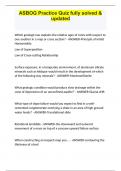
-
ASBOG Practice Quiz fully solved & updated
- Exam (elaborations) • 24 pages • 2024
-
- $7.99
- + learn more
Which geologic law explains the relative ages of rocks with respect to one another in a map or cross section? - ANSWER-Principle of Initial Horizontality Law of Superposition Law of Cross-cutting Relationship Surface exposure, in a temperate environment, of aluminum silicate minerals such as feldspar would result in the development of which of the following clay minerals? - ANSWER-Montmorillonite What geologic condition would produce slow drainage within the cone of depression of an unco...
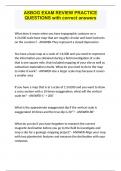
-
ASBOG EXAM REVIEW PRACTICE QUESTIONS with correct answers.
- Exam (elaborations) • 26 pages • 2024
-
- $7.99
- + learn more
What does it mean when you have topographic contours on a 1:24,000 scale base map that are roughly circular and have hachures on the counters? - ANSWER-They represent a closed depression You have a base map at a scale of 1:6,000 and you need to represent the information you obtained during a field investigation of a site that is one square mile, that included mapping of your site as well as subsurface exploration results. What do you need to do to the map to make it work? - ANSWER-Use a large...
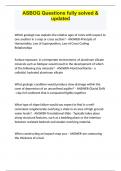
-
ASBOG Questions fully solved & updated
- Exam (elaborations) • 39 pages • 2024
-
- $7.99
- + learn more
Which geologic law explains the relative ages of rocks with respect to one another in a map or cross section? - ANSWER-Principle of Horizontality, Law of Superposition, Law of Cross-Cutting Relationships Surface exposure, in a temperate environment, of aluminum silicate minerals such as feldspar would result in the development of which of the following clay minerals? - ANSWER-Montmorillonite - a colloidal, hydrated aluminum silicate What geologic condition would produce slow drainage withi...
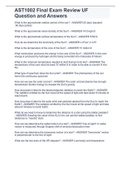
-
AST1002 Final Exam Review UF Question and Answers
- Exam (elaborations) • 14 pages • 2022
-
- $9.99
- + learn more
What is the approximate rotation period of the sun? - ANSWER 25 days (equator) 36 days (poles) What is the approximate mean density of the Sun? - ANSWER 1410 kg/m3 What is the approximate surface temperature of the Sun? - ANSWER 5780 K How do we determine the luminosity of the Sun? - ANSWER L=Flux* 4 π R² What is the temperature of the core of the Sun? - ANSWER 15 million K What mechanism produces the energy in the core of the Sun? - ANSWER In the core, energy is produced by h...
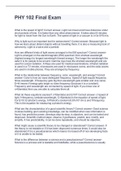
-
PHY 102 Final Exam
- Exam (elaborations) • 16 pages • 2022
-
- $13.49
- + learn more
What is the speed of light? Correct answer- Light can travel enormous distances under short periods of time. It is faster than any other phenomenon. It takes about 8 minutes for light to travel from the Sun to Earth. The speed of light in a vacuum is c=3x10^8 m/s. Why is light such an important tool for astronomers? Correct answer- Because light is how we learn about distant objects without travelling there. It is also a measuring took of astronomy. Light is a wave and a particle. How are ...

Study stress? For sellers on Stuvia, these are actually golden times. KA-CHING! Earn from your study resources too and start uploading now. Discover all about earning on Stuvia


